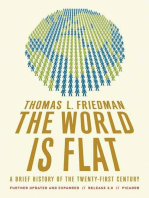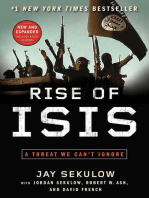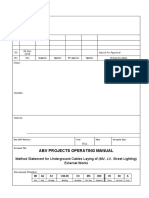0 ratings0% found this document useful (0 votes)
79 viewsXII
XII
Uploaded by
UET MAINCopyright:
© All Rights Reserved
Available Formats
Download as PDF or read online from Scribd
XII
XII
Uploaded by
UET MAIN0 ratings0% found this document useful (0 votes)
79 views32 pagesCopyright
© © All Rights Reserved
Available Formats
PDF or read online from Scribd
Share this document
Did you find this document useful?
Is this content inappropriate?
Copyright:
© All Rights Reserved
Available Formats
Download as PDF or read online from Scribd
Download as pdf
0 ratings0% found this document useful (0 votes)
79 views32 pagesXII
XII
Uploaded by
UET MAINCopyright:
© All Rights Reserved
Available Formats
Download as PDF or read online from Scribd
Download as pdf
You are on page 1of 32
Xil. APPENDIX
THE DICTIONARY IS THE ONLY PLACE
WHERE SUCCESS COMES BEFORE WORK.
VIDAL SASSOON
SN
‘eMaice 2019 Xil-4 (© QUALITY COUNCIL OF INDIANA
XI APPENDIX
DEFINITIONS
Definitions of Key Quality Terms
(Basically the same as ISO 8402 - with additions)
Accreditation
Artificial
intelligence (Al)
Assure
Audit
Audit standard
Auditee
Auditing
organization
Auditor
Automation
Autonomation
Big data
Blockchain
Capability
The act whereby a nationally recognized body approves an
organization to operate an audit and registration program.
is the broad science of mimicking human abilities, and machine
learning is a specific subset of Al that trains a machine how to
learn.
To give confidence to oneself or to others.
See quality audit.
An authentic description of essential characteristics of audits
which reflects current thought and practice.
The organization being audited.
A.unit or function that carries out audits through its employees.
This organization may be a department of the auditee, client, or
an independent third party.
See quality auditor.
Using technology to perform processes with minimal human
assistance.
A form of automation with human elements connected. When an
equipment maifunction occurs, a signal indicates a problem. The
operator or maintenance personnel must respond to find the
source of the problem, and resolve it.
Incorporates large data sets, from a wide variety of sources, and
data is generated at a rapid pace. Predictive modeling of the
data provides insights regarding changes in products and
services desired by customers.
Shared ledgers of transaction data, that once recorded, the data
in any given block cannot be altered retroactively.
The ability to perform designated activities and to achieve results
which fulfill specified requirements.
CCMaIOE 2019
xul-2 ‘©QUALITY COUNCIL OF INDIANA
Xi, APPENDIX
DEFINITIONS
Definitions of Key Quality Terms (Continued)
The authoritative act of documenting compliance with agreed
requirements.
An impartial organization possessing the necessary competence
to operate a certification program.
Client The person or organization requesting an audit. Depending on
circumstances, the client may be the auditing organization, the
auditee, or a third party.
Cloud computing A term for anything that involves delivering hosted services over
the Internet. Five of the main benefits of cloud computing are:
self-service provisioning, elasticity, pay per use, workload
resilience, and migration flexibility.
Company A term used to refer to a business, the purpose of which is to
supply a product or service.
Compatibility The ability of entities to be used together under specific
conditions to fulfill relevant requirements.
Compliance A judgment that a product or service meets the requirements of
a specific standard.
Contract An accepted order. The agreed requirements between a supplier
and customer transmitted by any means.
Contract review The systematic acti s carried out before signing the contract,
to ensure that requirements for quality are adequately defined,
free of ambiguity, documented and realizable by the supplier.
Contractor Assupplier.
inate the causes of an existing
nonconformity, defect, or other undesirable situation to prevent
recurrence. The distinction between “correction” suchas repair,
rework, or adjustment and “corrective action” is that the former
relates to the disposition of an existing nonconformity, whereas,
“corrective action” relates to the elimination of its causes.
Corrective action
‘cmavoe 2019 xu-3 (© QUALITY COUNCIL OF INDIANA
Xi. APPENDIX
DEFINITIONS
Definitions of Key Quality Terms (Continued)
Customer
Defect
Define
Degree of
demonstration
Dependability
Design review
Discrepancy
Disposition of
nonconformity
Document
Documentation
Ensure
The ultimate consumer, user, client, beneficiary, or second party.
Also: the recipient of a product or service provided by the
supplier.
The nonfulfillment of intended usage requirements. The
departure or absence of one or more quality characteristics from
intended usage requirements.
To make clear; make distinct; to fix the limits of.
The extent to which evidence is produced to provide
confidence that specified requirements are fulfilled. The extent
depends on criteria such as economics, complexity, innovation,
safety and environmental considerations.
The collective term used to describe the availability of
performance and its influencing factors: reliability performance,
maintainability performance and maintenance support
performance. Dependability is a time-related aspect of quality.
A formal, documented, comprehensive and systematic
examination of a design to evaluate the design requirements and
the capability of the design to meet the requirement for quality
andto identify problems and propose solutions. A design review
can be conducted at any stage of the design process.
A failure to meet the specified requirement(s), supported by
evidence. (Other words used interchangeably: nonconformance,
deficiency, finding.)
The action to be taken to deal with an existing nonconformity
condition in order to resolve the nonconformity.
Something written or printed, that gives information or proof;
any object used as evidence; to prove or support by means of
documents.
The use of documentary evidence; the documents used.
To make certain.
COMIC 2019
U4 (© QUALITY COUNCIL OF INDIANA
Xi, APPENDIX
DEFINITIONS
Definitions of Key Quality Terms (Continued)
Inspection
Instructions
Interchangeability
Iso
Lead auditor
Machine
learning (ML)
Management
review
Model for quality
assurance
Nonconformity
Activities such as measuring, examining, testing or gauging
characteristics of an entity and comparing the results with
‘specified requirements to determine whether conformity is
achieved for each of these characteristics. The process of
comparing an item, product or service with the applicable
specification.
Detailed written or spoken directions given in regard to what is
to be done.
The ability of an entity to be used in place of another to fulfill the
‘same requirements.
International Organization for Standardization.
idual appointed by the registration organization to be
le for the quality audit. The team leader who
supervises other auditors.
‘A method of data analysis that automates analytical model
building. Itis a branch of artificial intelligence based on the idea
that systems can learn from data, identify patterns and make
decisions with minimal human intervention.
A formal quality evaluation, by top management, of the status
and adequacy of the quality system in relation to quality policy
and new objectives resulting from changing circumstances. A
management review may also be called a quality system review.
Management reviews may include a review of the quality policy.
Quality audit results are one of the possible inputs to a
management review. However, this review is not just follow-up
on quality audits and corrective action. Management reviews
can be excellent improvement tools.
A standardized or selected set of quality system elements
ied to satisfy the quality assurance needs of a given
The nonfulfillment of specified requirements. The departure or
absence of one or more quality characteristic(s) or quality
system element(s) from specified requirements.
‘cMavoe 2019
XU-S (© QUALITY COUNCIL OF INDIANA
Xi APPENDIX
DEFINITIONS
Definitions of Key Quality Terms (Continued)
Objective
evidence
Organization
Organizational
structure
Preventive action
Procedure
Process
Product
Product liability
Production
permit
Information which can be verified, based on facts and obtained
through observation, measurement, test or other means.
A company, corporation, firm, enterprise or institution, or part
thereof (whether incorporated or not, public or private) that has.
its own function(s) and administration.
The set of formal and informal responsibilities, authorities
and relationships, arranged in a pattern, through which an
organization performs its functions.
An action taken to eliminate the causes of a potential
nonconformity, defect or other undesirable situation, to prevent
occurrence.
A specified way to perform an activity. When a procedure is to
be documented, the term “written procedure” or “documented
procedure” is preferable. A procedure should normally specify:
the purpose and scope of an activity; what is to be done and by
whom, where and how it must be done; what materials,
equipment and documents shall be used; and how it must be
controlled and recorded.
A set of interrelated resources and activities which transform
inputs into outputs with the aim of adding value. Resources
include personnel 5, equipment, technology,
methodology and finances. The aim of adding value is quality
related.
The result of activities or processes. A product can be tangible
or intangible, or a combination of both.
Ageneric term used to describe the responsibility of a producer,
or others, to make restitution for any loss related to personal
injury, property damage or other harm caused by a product or
service. Liability is defined by law so it may vary from country
to country.
A written authorization for a product, prior to its production, to
depart from originally specified requirement; also known as
“deviation.”
‘CMQIOE 2010
XI (© QUALITY COUNCIL OF INDIANA,
Xi, APPENDIX
DEFINITIONS
Definitions of Key Quality Terms (Continued)
Purchaser
Qualification
process
Quality
Quality 4.0
Quality
assurance
Quality audit
The customer.
The process of demonstrating whether an entity is capable of
meeting specified requirements.
The totality of characteristics of a product or service that bear on
its ability to satisfy stated or implied needs.
Ina contractual environment, needs are specified. Whereas, in
other environments, implied needs should be identified and
defined. In many instances, needs can change with time; this
implies periodic revision of requirements for quality. Needs are
usually translated into characteristics with specified criteria.
Quality is sometimes referred to as “fitness for use,” “customer
satisfaction,” or “conformance to the requirements.”
It is the pursuit of excellence in the digital transformation. The
use of big data, data analytics and predictive modeling are now
necessities for organizations to survive.
All the planned and systematic actions to be implemented, and
demonstrated to provide adequate confidence that the product
or service will satisfy given requirements for quality. lll that is
done to be sure that quality control is what it should be. Wi
an organization, quality assurance serves as a tool to provide
confidence to management (internal quality assurance). In
contractual or other situations, quality assurance also serves to
provide confidence to the customer or others (external quality
assurance).
Asystematic and independent examination to | determine whether
quality activities and related results comply with planned
arrangements and whether these arrangements are implemented
effectively and are suitable to achieve the objectives. Quality
audits are carried out by staff not having direct responsibility in
the areas being audited.
One purpose of a quality audit is to evaluate the need for
improvement or corrective action.
‘eMaioE 2019
xu-7 © QUALITY COUNCIL OF INDIANA
Xil, APPENDIX
DEFINITIONS
Definitions of Key Quality Terms (Continued)
Quality audit
observation
Quality auditor
Quality contro!
Quality
document
Quality
evaluation
Quality
improvement
Quality
management
Quality manual
A statement of fact made during a quality audit and substantiated
by objective evidence.
A person who has the qualification status to perform quality
audits, The one doing the auditing.
The operational techniques and a s that are used to fulfill
requirements for quality. All that is done to be sure that the
productis whatit should be. Quality control involves operational
techniques and activities aimed both at monitoring a process
and at eliminating causes of unsatisfactory performance at all
stages of the operation in order to generate economic
effectiveness.
A document that contains the requirements for quality system
elements for products or services, or the results of activities
such as inspections or quality audits.
A systematic examination of the extent to which an entity (part,
product, service, or organization) is capable of meeting specified
requirements. A quality evaluation may be used to determine
supplier quality capability. In this case, the result of quality
evaluation may be used for qualification, approval, registration
or accreditation purpose:
The actions taken to increase the value to the customer by
improving the effectiveness and efficiency of processes and
activities throughout the organizational structure.
All activities of the overall management function that determine
the quality policy, objectives and responsibi and
implements them by means such as quality planning, quality
control, quality assurance and quality improvement. The
responsibility for quality management belongs to all levels of
management but must be driven by top management. Its
implementation involves all members of the organization,
A document stating the quality policy and describing the quality
system of an organization. A quality manual may relate to the
totality of an organization's activities or only to a part of it.
COMaIGE 2019
Xl-8 © QUALITY COUNCIL OF INDIANA
XI, APPENDIX
DEFINITIONS
Definitions of Key Quality Terms (Continued)
Quality manual
(continued)
Quality plan
Quality planning
Quality policy
Quality-related
costs
Quality
requirements
Quality
surveillance
Quality system
A quality manual will normally contain, or refer to, the quality
policy, the responsibilities, authorities and inter-relationships of
personnel who manage, perform, verify work affecting quality,
the quality system procedures and instructions, etc. A quality
manual can vary in depth and format to suit the needs of an
organization.
A document setting out the specific quality practices, resources
and sequence of activities relevant to a particular product,
project or contract. A quality plan pertaining to a specific
application usually references the quality manual.
Establishing and developing the objectives and requirements for
quality and the requirements for the quality system application.
Quality planning includes the preparation of quality plans and
provisions for quality improvement.
The overall quality intentions and direction of an organization
regarding quality, as formally expressed by top management.
A part of the overall costs considering the expenses incurred in
ensuring and assuring satisfactory quality as well as the tangible
and intangible losses incurred when satisfactory quality is not
achieved.
A translation of customer needs into a set of quantitatively or
qualitatively stated requirements for the characteristics of a
product or service to enable its realization and examination. The
requirements for quality should be initially expressed in
functional terms and documented.
The continuous monitoring and verification of the status of an
entity (part, product, service, organization, etc.) and an analysis
of records to ensure that requirements are being fulfilled.
The organizational structure, responsibilities, procedures,
processes and resources for implementing quality management.
The quality system of an organization is designed primarily to
satisfy the internal requirements of the organization and is not
limited to the quality assurance requirements of a particular
customer. For contractual or mandatory quality assessment
purposes, demonstration of the implementation of identified
elements of the quality system may be required.
‘cmavoe 2019
Xi. (© QUALITY COUNCIL OF INDIANA
Xl APPENDIX
DEFINITIONS
Definitions of Key Quality Terms (Continued)
Record
Registration
Reliability
Repair
Requirements of
society
Rework
Safety
Self-inspection
Service
‘A document which furnishes objective evidence of activities
performed or of results achieved. A quality record provides
objective evidence of the extent of the fulfillment of the
requirement for quality or the effectiveness of the operation of a
quality system element. Some of the purposes of quality records
are: demonstration, traceability and corrective actions. A record
can be written or stored on any data medium.
Formal verification by an accredited body that an organization
has been audited and shown to comply with ISO 9000.
The
conditions for a defined pi
lity of an item to perform a required function under stated
iod of time.
The action taken on a nonconforming item so thatit will fulfil the
intended usage requirements although it may not conform to the
originally specified requirements.
Requirements including: laws, statutes, rules and regulations,
codes, environmental considerations, health and safety factors
and conservation of energy and materials.
The action taken on a nonconforming item so that it will fulfill the
requirements as originally specified.
The state in which the risk of harm or damage is limited to an
acceptable level.
Inspection of the work performed, by the performer of that work,
according to specified rules.
The supplier or customer may be represented at the interface by
personnel or eqi
the supplier may be essential to the service delivery. Delivery or
use of tangible products may form part of the service. A service
may be linked with the manufacture and supply of tangible
products.
CcMaIOE 2019
XI 10 © QUALITY COUNCIL OF INDIANA,
Xi, APPENDIX
DEFINITIONS
Definitions of Key Quality Terms (Continued)
Socratic Alearning-centered approach that challenges a person to develop
questioning their critical thinking skills and engage in analytic discussion,
which leads to independent learning and thinking, It is at the
heart of critical thinking, and can be used to explore ideas, to get
to the root of things, to uncover assumptions, and to analyze
complex concepts.
Specification Documented detailed requirements with which a product or
service must adhere to.
Sub-contractor The organization that provides a product or service to the
supplier.
Total quality Amanagement approach of an organization, centered on quality
management with a global strategy, based on the pation of all its
members and aimed at long term profitability through customer
satisfaction, including benefits to the members of the
organization and to society.
Traceability The ability to trace the history, application or location of a
product and in some cases service by means of recorded
identifications.
Validation Confirmation by examination and provision of objective evidence
that the particular requirements for a specific intended use are
met. Validation i is normally performed on the final product under
defined operating conditions, and when necessary, performed in
earlier production stages.
Verification Confirmation by examination and provision of objective evidence
that specified requirements have been met.
In design and development, verification concerns the process of
examining the results of a given activity to determine conformity
with the input requirements.
Also known as a geographically dispersed team, orremote team,
is a group of individuals who work together from different
geographic locations, and use technology such as email and
video conferencing to collaborate.
Waiver A written authorization to release a product which does not
conform to the specified requirement. Also called “concession.”
‘eMa/oE 2019, xu-44 © QUALITY COUNCIL OF INDIANA
Xi. APPENDIX
INDEX
Author/Name Index
‘Accipio 1-78
‘Adams, 8.12
Albrecht, K. Vil
‘Albrecht, S. VIF-54
‘Allon, 7.%37
‘Altshuler, 6. E115
“Ambrosi, J. 1V-110
‘Anderson, K. Il-S4
‘Anderson, PP, IV-110, 35
‘andrade,R. Vis 18
‘wine, 8.1V-410
Bailey, K.VILSS
Baisley, RD. VIS
Baruch, J 60, 1-113
Basil V.VIEES, VIE
atoman,T.S 1-79, V0
Bochtol MLL. MSE
Beers, M.IV-110
Boll, C.R.VIS4, 35
8
eC. 80
fenis, W. I-79
Bensley, FA. intro, I-58, V-60, K-35,
Besterfel, D.H. I, I-58, Vit18, ISS, X35
Bestorfola, GH. ViN-S4
‘Besterield-Michna, C.VI-S6
Besteriels-Sacr, VISA
ested, JL. KS
‘Bhandari, L Vi-66
Bhote, KR. Vil, X35
Bigelow, J.0.1V-110,
Bigelow, 8.1.60
Birsner, EP. VIl-54
Blanchaed,K. I-78, W413, 1-144
Bock, L X37
Bogan,C. v-60
Bomneit,R.D. VAI
sort, JL. 58
Bowles, 8. VIS
Bowman, C. LS8
Bowyer, K.ik79
Brache, A. X38
Brassard, M. i115
Brenton, Into-3
Breyfogio, FW. I Vi-A15
Burgolman, $8, 1V-110
Caldiera, G.Vi-es
Campanalia, J. VIS
Gampbell,D. X37
arison, R182,
Cavanaigh, RR. V-118
(Chen, £38
Giampa, D. H, v.60, vind
Causing, D.Vitt5, Vit16, Vt
Cohen, R.Vil-S¢
Conner, 6. Vit
Coombs, GF. V7
Covey, SR. 38, V.57-V-60
Cox, J. vE6
(Cramer, T. Intros
Crosby, PB. V-38, V4, V-50, V-60,
Cutter, AN. v.80
Daughtry, A.1V-113
62, 120, I-86, 1-36
vss
Davenport, T.1V-110
Davis, 8.8. 4,80,
ar
Dawson, J. VILSS
Deal, T.1L79
DeBono, E. ViA15
Delohaye, 8 X38
Delavigne, KT.V-10, v-60
Delbecg, A. 45
DeLong, D.V-110
Deming, W.E. V9, V42-V-45, V-60, ViA15, VI-6S
58,11, 84, Vit 46, VII, X38,
Densmore, B.1V-110
eure, B.intro-3
Deveau, D.1V-110
Dobbins, RK. DX35
Dodge, HL. VIS
Dodson, M.Intro-3
Domb, ER. Vitis
Dovich, RA. VIS
Dreo, H.IV-140
Drucker, P. 1-79, HSB
Duty, J'1v-110
Dyer, W.G. 1-79
Edenborough, NB. ViA15
ington, J 1.79, VEt15
English, 1. v.60
Ettore, B. Vil-S4
Extrom, M.IV-110
Fallow, AX37
Feigenbaum, AV. 4, I-58, IV-110, V3, V5, 52, V.6t
Flipezak,B. 1-79
Foster, R80
Gaebler, T. LSE
Galbraith, 2 1V-411
Galvin, B, Vids
‘Gandhi Dt
Geddes, L Vs4
Gee, 6. intros
Geneon, H..1V-111
Gerstein, MS. 1184
Gib, KeIvett4
Gib, T.v-itt
Ginn, M.IV-113,
leason, G. VSS
Goetsch, DL. M4, 1.80, M8, 1-11, V-81, VIAI6, VIS,
35,37
Goldratt, E Vi416
Goodstein, 58
Gordon, J. 1480, V-411
Gould, L. Vist
Gracssei, 8. VISS
Grant, E-L. VEt16, VIS
Grice, P-1K-35
Griffin, A Vis
Gain, RW. IV-113,
Gryna, FM 59, VS
‘OMaIOE 2019
xuL-412 ‘© QUALITY COUNCIL OF INDIANA
Xi, APPENDIX
INDEX
Gundiing, E1180, ViA16
Mackoan, Rh
Hahn, 6. E116
Hamel, G. I-58, V-113, ViA16
Harrington, H+ -S8, V-14, 1-191, I
Harry, M. V6, Vii16
Hartman, RV-81
Hashimoto, 7. i416
Hauser, JR. VE116, VSS
Hayes, 8. VlLss
Hayslip, W.R. I-55
Horsey, P.1V-13,1V-111
Herzberg, FW. 138, 1-80
Heskott, di. VSS
Howit, 8. VI-8s
Hi, W.Vi416
Hirsh, 56. 1V411
Hite, 8.1v-141
Hoer,R. VEt18
Hofstede, 6. 1-80
Houser, WF. K-36
Hunter, MLR. V-35
Huwe, J.X37
lacocea, LX
Ima, ML VEAT7
reson, W.G. ViA17
Ishikawa, KIVA, IVA12, V-30, 58, V-54 V6, V417, Ve
38
Ivancevieh,J-1180,1V-112
sani, Lg
‘ro, Kvi20
‘Johnson, E..Vi-117
‘Johnson, .B.V-112
‘Johnson, W. X37
‘oie, B.L i-62
‘Jones, A. W112
‘Jones, 0. Vi-120
‘Jones, T.0. Vis
‘Doran, JM, 4, 1-80, 1.59, V39, V.46-V-48,V-62, VEN17, Vile
65, Vil-S5, 35
Kaplan, 88. 88, 82
Kazuo, 0. Vi-t19
Kendll, J. M-59,V-112
‘Kennedy, A. 1-79,
Kennon, J.1V-112
Kepner, GH. VEI13, Vid17
Keraner, H.IV-112
Kirtpatick, D.X-37
Krause, 0.6. il-55
Krumwiede IV-117
Keng, P.IV-12
Kumnerow, JM. V-111
Kunkel, P.v-110
Lal, R37
Landers, A. Vi-t
Langley, ¢. vi-i18
Lasehinger,D.intro-3
Latako, Wel. V-82, VIANT, VIS
Leavenworth, R. VIAI6, VIS
Leland, K, v5
Lennon, intros
Levinson
Long, B.
Lorner tt
Loveman, .W. VS
Lowenstein, MLW. VIS
Macphorson, A.I81
Magnet, D intro
Maraton, WM. WA7,IV-112
MartinD. Vi-t17
Maslow, AM. I-32, 1:3, 1-81
Mattoson,M: 1-80, W142
Mausman, B.-80
Mayo, E132
Metal, W.X-7
McCarty, P.. Vil-56
McCartney, P intro
McClelland, D.1V-112
MeGregor, 0.1133, 1134, 181
Molan,E. Vit?
Molcher, RW. IV-112
Metkman, A. VI-56
Mendonca, M. VI-E®
its, J1V-113
Mintzberg, H.th8t,
Mitchel, 7.110
Mizuno, 8. 118
Moon, R. VIL8S
Moody, P. Vi19
Moorhead, G.IV-113
Moss, R.Vit17
Myers, KD. W113
Myers, P.B.IVA13
Nadler, DA. I-81
Nakajima, 8.418
Nand, V. VI-86
Nowman, PR. Vit18
Nierenberg, G.I
Nolan 7 58, I-86
‘Norton, D.P. 52, V-62
Ohno, T. i418
Oldham, 6.1-80
‘Omdah T. , VIA18, VIE, X35
Osbore, D. Vis
Parer,€.6.1%36
to, V. VAS
Pasteur, L.xi-t
Patol, J intro-3
Ree
Peale, NV. 1-79
Pearson, ¥.N
Peters, T. VSB
Priter, J. N58
ke, M.S. N18
Philips, 8. VI-S4
Poole. 1V-110,
Porter, M.-8, 1-60
CcMaIoE 2019
xiL= 13
© QUALITY COUNCIL OF INDIANA
Xi, APPENDIX
INDEX
Poteet, M.X-37
Prahalad, C.1V-113, ViA16
Preiss, R.Vi-S5
Provost, L. ViA18, Vi-sé
Pugh, 8. 65, VENA
ul, J 80,1913
Raisinghani .V-113
Rock, IB
Reese, 11-81
Richardson, WER. Introd
Ricks, 8.
Riggs H.
Robbins, Nott
Robert, M60, 1-38,
Roberts, C.V-82
Robertson, J.D..V-110
Robinson, A. Vit18
Robinson, D. X37
Robinson, J. X37
Rombach, H. VI-ES
Romig, HG. VILS
Rosenau, M. Vit19
Rosenbloom, R.1V-110
Ross, Pl. Vit19
Ross, RB. V-62
Rother, M. Vi19
‘Sasser, Je, WES. VIS
‘Sassoon, V. Xi
Sati, V.IV-i14
‘Saundors, D.M. V-62,V-117, VILBS
Sayle, A V.62
‘Schaaf, O. Fs
‘Schargel, FP. I-56
‘Senge, PAM, 1V-114, V-62, E118, VILE
‘Shankiin, M.1V-110,
Sharma, A. e119
Shaw, RB.
Sherman, 8.182
Shevenaugh, D. VILSS
Shewhart, W.A.V-38-V-4t,V-62, VI119, VIL6S
Shigeru, M. Vi-119
Shingo, 8. V-105, Via19,
Shockley, Il, WeIV-114
Shook, J. VIS
‘Simmerman, S.J. Vil-56
‘Sinha, MA, VSG
‘Su, R82
‘Smith, BJ V-62, X38
‘Shee, RD. V-11, VI-S6
Shyderman, 8.1180
Solomon, C.1V-114
Spector, R. VISE
Spenco, Iv-tt4
Sproul, R.VI-LTB
Stein, PG. Intro, VIKES
Stengel, C. 5
Strelbel, B82
‘Strickland, MA. -60,1V-114
‘Sword, M. il-54
‘Taguehi, G. V-3, V-55, V.56, V-62, Vit19
Totsuichi, A Vit19|
‘Thomas, K-82
Thompson, Jf A. MED, Wott
‘Thoreau, HD.
Tichy, N82, X38
Tosvotd, 0. W-82
Trogoo, 8.8. i413, Vit7
‘Trochim, W.X-38
‘Tackman, BW. 182
Van doVen, A. 45
Van Landingham, RD. VSS
Vines, €.1Va14
Wald, A Vi-66
Warechaner V-416
Warzusen,
Watson, 6.60
Weisbord, MR. 60
Wescott RT. Kt
Wheetright,S.-58
Wiiteley, RC. VSB
Wil, D. x38
‘Wk, Lav .82
Womack, J.Vi120
Wertman, BL intro, ntro-, I-82, H-60, 1V-110, V-60, V-62,
"Vi-120, VIES, Vi-6E, X35, 1K-36
Wu, ¥. v.62
Wysocki, RK. IV-IT4
Yang, K.V-120
Zang, WAL W114
Zeidler, P. V5
Zeithaml.
Zemke, R. VIS4, VISE
Zhang, H. Vi-tz0
Zien, K-60, W443
Zinkgrat, 8. VEN16
cmaioe 2019
XU 14 {© QUALITY COUNCIL OF INDIANA
Xi, APPENDIX
INDEX
Subject Index
44 stop approach to quality improvement V-50,
24 CFR Part 620'V-23
53.4 parts per milion Vi46
‘whys VIS.
We and HVS
ssviez
A
ABC (activly-based costing) N48
‘Accept number VIS
‘Acceptable qual
‘Accommodating kt, 42
‘accrediation X1-2
‘Accuracy Vila
‘M38
‘Acquisition VIN-40
‘ActiN-25, Vaz, VIS
‘ction Viat
‘ative istening 1V-74
‘tivity network diagrams (ANDs) 1V-100, V32, V3
‘Acivity-based! costing (ABC) I-48
‘Actual
‘Actual general manager performance IV-6
‘Ad hoc teams Ist
‘Adjouring W-55.
‘Aaministration 1V-38
‘Administrative management V-9
technological training tools X-26
‘Affected parties Vil-tt, VIZ
‘Afinity dlagrams Vi-20, Vi-2t
‘Agreoableness W-18
Al (artical iteltigence) 30
‘Aligning goals with stakeholder needs 1-22, -23.
‘Aignment with stratogienoods X-8, X29
‘Alliances and joint ventures 1-8
‘Allocating resources V-5,
‘Alpha dak VIS, VIEAS
‘Analysis X12%-16
‘Analyze 122, Via5
‘Andon board Vi-87
‘ANDS (activity network diagrams) 1V-00, V-32, E33
Wao
‘ANSUASQ 21.4 VI-TOVI-12, VI-t4
‘cod letors Vil-tt
‘ingle sampling, normal inspection VI-12
ANSUASQ 21.9 Vil43, VIF14
‘sampling plans Vi-13
‘Aposte Vileat
‘Application of adult learning principles X20, X21
‘Applications of classical taining tools X24
‘Apply 22
‘Appraisal costs V-68, V9, VET2
‘Appropriate vehicles fr different situations V-72,
‘APR (annual percentage rate) V4
‘AGI (acceptable quality level) VIB
Artifacts 1-27
‘Aticilintligance (Al) M-30, XIL2
‘ASQ Code of Ethles1-75,11-76
‘ASQ international Team Excollence Award (TEA) 29
980.24.4 VI-NO-VI-N2, VIEIS
‘code letters VI-11
normal inspection VIL¢2
88071.8 Viet, V-t4
‘sampling plans Vit
‘Assessment
‘and analysis, benefits I-32
‘and analysis, need for I-31, 32
process steps I-35
echnical M3335
Assets 43
‘Assure XI-2
‘Asynchronous communications W-83,
[ATF (Bureau of Alcohol, Tobacco, and F
‘stibute VIB
‘hart formulas VIE3S
charts VI-32
control chart VIL2S
plans Vit
‘Attibutions 1-69,
‘triton Vi-40
‘auc x1-2
internal V-43
ually Veit
Standard XI-2
136
‘Auclting organization X12
‘aditor X12
‘Automatic measurement VI-3
‘atomationt-29, X12
‘atonomation I-29, X02
‘Autonomous work teams I-32
‘allay VOT, VIO
‘of information and knowledge 1V-82, V-63
‘Average Vil27.
‘Avoidance 1V-58
‘Avoiding i, 42, VES
‘Axiomatic design Vi-53, Vi-64
Balance sheet 1-43,
Balanced ViA09
Balanced scorecard M52, N53, V2, V-13
Balarige National Quality Program (BNGP) I-12
Baldrige Performance Excellence Program I-12, V24-V-28
Bar charts 1.98, 1-59
Barriers to empowerment I-46, 147
Basle Vil-20
problem solving methodology Vi-3
Bathtub curve VI-63
Bathtub model VI-63
Bayesian sampling VI-14
Behavior X35
Behavioral approach to management V-14
Behavioral assessment I-32, 33
Benchmarking V334.37
‘CMaIDE 2018
Xil -15 (© QUALITY COUNCIL OF INDIANA
XI APPENDIX
INDEX
organizational V.
performance V.36
process V.36
project V-26
Strategic V7
Bonefit-cost analysis 1-41
Benefits of assossmont and analysis -32
Best company improvement stratogies V-37
Beta risk ViF8, VI-1S
Bias V3, Viis0
Big data XiL2
five factor model of personality 1V-18
Big Qand Lite @ 48
‘Bimodal histogram Vi-12
inomial distribution VIL2S, VIEIS
Black belt duties VIA7
‘Blockehain I-29, X02
‘Bloom's Taxonomy 122
'BNOP (Baldrige National Quality Program) I-12
Boss Wad
Bottleneck Vi-109,
Brainstorming VES4
Broad stratogie objectives m8
Budget IV-47, 1-86,
Build phase I-56
Bureau of Alcohol, Tobacco, and Firearms (ATF) I-36
Bureaueracy V-10
Burn-in V-60,
Business environment analysis I-14
Businoss practice Il34, I-76, (V-77
c
chart Vi.32, Vilas
‘Caype metrxdlagrams V-26
Capability x0-2
‘analysis M34
“analysis objectives VILS4
Index tailor rates VILSS
process VIKS#-VI-53,
Capability index (Cp) VI-S2, VIss3
Capability ratio (Cr) VI-S2
CCAR (corrective action request) 1X20
(Case study questions Xh4-X42
‘question #1 Xi-2
‘quostion #2 X13
‘Quostion #3 X14
question #4 XLS
Question #5 X68
‘question 86 XLT
{Question 7 X18, X19
‘Question #6 XI-A0XI-2
Cash flow V-49,
Catastrophic V-9, vi-40
{Gouse and efectciagrams Vi-4, VIS
‘GDC (Centers for Disease Control) I-36
Centers for Disease Control (CDC) I-36
‘Central limit theorem VIL23
‘GEO as change agent 20
‘GEP (Cortifed Excellence Professionals) V27
Certification X13.
ody x3
overview It
Certified Excellence Professionals (CEP) V-27
(CFM (continuous flow manufacturing) V-A7, V.98, Vis
Chain sampling Vi-t4, VIA
Champion 1-67
Change
‘agents U4
CEO as agenti-20
large seal 1-21, 1-22
‘management I-17
proces
broject example 1-20,
fesistance I-18
{pes of organizational 1-17
‘changing perceptions VIl-5t
CGharactoristies of a normaly distributed process Vi-413,
Check Vit, Ves
Check sheets V8, ViA0
recording V8, Vi-10
checklists V-10
Classical training tools X-22%25
(Cont xI-3
Closed ended questioning IV-72,1V-73
Closure v.84
oud computing I-28, X0-3
CCMAIOE Body of Knowledge 1-64-21
(CMOIOE exam 134-5
Coach W-14
Coefficient of variation (COV) Vik22
Collaborating Ira, Ir42
Golurmn graphs Vit1|
Combination VSS
‘Commitment tothe customer Vil-29, VI30
Common
cause VSO
‘communication actives 13
Continuous distributions I-24
Siserote distbutions VIL25
‘striations VIL26
team problems I-59
‘Communication Vl-25,
bles 1V-06
‘activities I-12
‘channels 1X43, 14
‘uring the contract 42, 1X3
sfectivene
ectronic etiquette 1V-82
global economy V-75:V-77
Rorizontat V-69
Impact on interpersonal IV-82
Informal v.69
positive x-14
Situational methods 1-83
shale 86
techniques V-66
technology N78.
vertical downward flow 1V-67
vertical upward flow IV-57:V-69,
Communicator V-66,
Company X1-3
Programs to Improve product safety I-40
‘Company wide quality control (WAC) V-7, v.54
Compatiity X13
Competency 1-76
Competing I-41, 42
‘Competition V7
cMavoe 2019
xU-16 © QUALITY COUNCIL OF INDIANA
Xil, APPENDIX
INDEX
Competitive shoppers V4
Complaints Vil-32
Compliance XI-3
Compromise Vil-s2
Compromising I-42
Concept design Vi-S2
Concept phase Vi-58
Concurrent activites V-100, 1V-01
Confidential I-76
Conflict
hanaing W-42
Fssues I-10, 1-102
of interest I-10041-102
Fesoluton 1-39-42, VILSL-MIN-SS
Confrontation Vil-52
CGonscientiousnoss1V-17,V-18
‘Gonsensus techniques 1-43
Constant allure rate VI-83
Constraints Vis08M1-112
‘management Vi-i1, Vit12
‘Consumer preducts I-38
Consumer's confiden
‘Consumer's risk Vi
Containment action 1-20
Contingency Theory W-10,
‘Continuous distribution Vi-24
‘Continuous flow manufacturing (CFM) VLS7, SE, Vi-88
Continuous quality Improvement (CAN V-38|
Contract XI-3.
review Xi
Contractor XIK3
Contrast of Big Q and Little q V-48
Control VAS
Control chart Vit
vantages Vi-14
tribute Vi-26, Vi-32
tribute formulas VIE3S
fissavantages V-14
Ietorpretation VI-3t
‘utof-contol VIISE-VIE38
Variables VIL26
Xbar-R ViL30
controling 1-4, 1V-86
‘Convenience Vil-22
Core competencies 1V-85
Corrective ation Vl-33, 1-23, 1X24, XIL3
‘commitment X24
‘ofined 1X20
‘efiitions 1X20
Improvement 1-21, 22
planning D625, 1-26,
Fequest form 1-23
‘Standardizing Vide
types 1K-24,1K25
Corrective action request (CAR) 1-20
Costs
‘accounting IV.47, 1V-48
‘dvantages of a qualty system VL76
Appraisal VSB, Vi89
‘tegories V-6B
extemal fallure V8, V-70
factors VIO
failure V-68
internal fallre V-68, Vi-70
Uimitations of quality system VIT7
‘mossurements VST
tetris (XAT
‘optimum quality V-74 M73
‘thor quality pitfalls V-77
prevention VE68, 69
‘ually comparison bases Vi74
quality improvement V-73
‘Quality responstbltis V-76
troditional concept VE
training X28
{ypleal quality report VTS
‘COV (coeficient of variation) VILZ2
Covey, SR. V-38,V-7-¥.88
p (capablityindox) VILS2, VIS, VI-SS
(pk vis, VI-S3
(CPM (erial path method) W-944V-97
‘example 1-944V-97
‘ca! (continuous quality Improvement V.38
Gr (capability ratio) Vi-52
Crash an activity IV-4.V-97, 1V108
Greate 122
Creativity 5, vs3
Criminal and personal lability 39
Critical VE38, Vi40
‘path 1.90, 1.91, V-93:1V-97, I-32
thinking skis 1-45
Cotical path method (CPM) 1V.944V-87
‘example 1V-S4:V-97
Cctcality Vireo
Crosby, PB, V-9, V9, V-50
Cross functional collaboration V-244V-26
(Gross functional teams 1-5, 1-53,
Cultural considerations 1V-76
Cutt 1254-27, 1-29,
lagnosis I-36
‘ational I-29
Current assets V-42
Current ratio 44
Curriculum development X-17, X18
Customer xika
‘commitment Vil-2, VI-30
‘consumer partnership VIl-49
‘domain VES
‘riven organizations VI-38
‘riven sorvies Viet, IAS
driven vision Vi-s4
‘employees Vil, ViI-S
‘expectations Vil-20-VI-22
fxternal VIE-0.V-15,
focus V2
identification
intermediate
intormal VIIA-VULS
loyalty Vilas
‘management VILSO, V-St
‘needs Vil-2, VIL23
eortes VIZ
Felationship mar
Fetention Vil40-Vil-43
Satisfaction VI-31-VH.33
Satlefacton surveys VI-35, VI-36
‘Segmentation Vil
serice VI-23|
service measurement VI-34
120
CMaIOE 2010
Xi -17.
© QUALITY COUNCIL OF INDIANA
XI, APPENDIX
INDEX
vice principles VI-46-Vi48
training Vil-23
voice VI-25
Customer focused organizations Vile, VIL2
references Vl-Sé
{eWaC (company wide quality control V-7, v.54
(yee time tks0, VST, V8, V-D, V-103
Tedltion V8, 91
D
Data
‘accuracy VIL6
Collection V3, VIET
Information knowledge development cycle 1V-60, V-61
Integrity Ves
e-bugging VIL60
Decision analysis Vi 14
Defect vir3s, Kil
Detection Vii-40
Detectives V-35
Defects per milion opportunities (DPMO) V-46
Defects por opportunity (OPO) Vi-46
ine Vis, Xia
Define, measure, analyze, Improve, control (OMAIC) VAS
Degree of demonstration Xi
Delogating IV
Delivery metrics 17
Deming method V-8
Deming, W.E. V-39, V42-V-45
‘chain reaction V-45
Dependabilty VIL60,XiL4
Deployment
‘action plan 48
ase study A847
‘of quality goals V-10
strategic goals I-46
Derating V6, VIESt
Desien
‘and development phase VI-58
Concepts VIO
review Xi
tusing quality function deployment V60
Design for six sigma (DFSS) V9
Designing for rllality VI-52--60
Desired vile21
Develop
phase 1-60
the mission i-7
the vision I6
‘win-win relationships 1-62
DDFSS (design for six sigma) V5
Different management siyles IV-125V-14
Direc abor V-48
Direct materials 1V-48
85
1 alning tools X24, X.25
of TaMv-32
technological training tools X27
DISC (Dominance, influence, Steadiness,
Consciontiousness) 1V-17,V-18
Discounts & plops Ito
Discovery sampling VI-I7
iseropancy XIl-4
Discrete aistribution ViL25
Disposal iLs8
Disposition of nonconformity XI-4
Dissatisfaction sources Vl-34
Dissatsfers 1-25,
Distribution of ime between fallures Vi-64
Distributions Vilz4, VIS
DMAIC (define, measure, analyze, improve, control) Vi-4S
Do M25, Ves, Vie, V2
Dominance 1V-17
Dominance, Influence, Stoadiness, Conscientiousness
(ISG) V-47, WA8
Dominant participants I-69
'DPMO (defects per milion opportunities) VAS
'DPO (detects per opportunity) Vid6
Dei vildo
Driving forces vi 12
E
E-business 128
Enmings before interest and taxes (EBT) 1V-45.
EBIT (earnings before interost and taxes) V.45
Effectcnuseretfect Vi110
Effective team meetings I-61
Effects of data collection on people IL-7
Effects of people on data collection VIL7
Effort 43
EFM (European Foundation for Quality Management) V-28,
v29
Electronic communication etiquette V-
Empathy V-71
Employ
‘communications Vil, Vil-8
‘surveys V7
training Vik, Vil-s
Empowerment I-46, V-12
barrens 4, 1-47
‘organizational I-47
End users VLt1
Engineering V-20,
Ensure Xin
Environment VILE
Environmental 123
actors VIS
sues 37
Environmental Protection Agency (EPA) I-37, V-23
Environmental stress screening (ESS) VIET
Envisioning 1-20
EPA (Environmental Protection Agency) I
Error proof V-102
spouted values 1-27
ESS (enviconmental stress screening) VILS1
Establish winawin plans I-37
Establishing process goals V-80
Esteem needs 1-32, 133,
Ethical decision models 1.78
Ethical principles I-76, 1-77
European Excellence Award V-28,V-29
European Foundation for Quality Management (EFQM) V-28,
v.29
Evaluat 1:22
Evaluating t
Evaluation
Internal supplior systems X24
7,123
ning effectiveness X-28,
‘omaioe 2019
x= 18
©QUALITY COUNCIL OF INDIANA
Xi, APPENDIX
INDEX
‘of supplier through product samples X-3
‘of taining effect on trainee X20, X31
Evaporating clouds VI-"10,
Evo (evolutionary project management) V-88,
Evolutionary project management (Evo) 1-88
Excellence Canada V.26, V.27
Execution V-64
Expectations of a quality professional I.75
Expected Vil-20
Exploration VSS
Exponential eistribution VIL24
External
cerification models 1-5-7
customer identification Vil-12, I-13
‘customer market segmentation il-14, ViI-1S
customers Vil-10-V15
failure costs Vi-68, Vi-70, V-72
performer factors X-8
extraversion 1V-16,1V-18
Extrinsle factors 135
F
Face-o‘ace interviews Vil-34
Falsafe VIL6O
Failure
‘analysis VILE1
‘costs V8, VITO
critical VILE!
mechanism VI-64
mode VIS
random VIKSt
rate VILS1, VIS
Fates VIESS
Failure mode and effects analysis (FMEA) Vi-34.V1-36, VI-6t
Failure mode effects analysie and critically analysis,
(FMECA) V-36.V-38
process steps VIS6, VIS7
Failure reporting, analysis and corrective action system
(FRACAS) Vil6t
False management assumptions It
Fault notation VI-E1
FDA (Food and Drug Administration) 36
FDACGMP v.23
Feedback Vi-32, Vl37
‘forme Vil-37
from stakeholders V4
Feeling W-18
Feigenbaum, AV. V9, V5, V-52
Feuaing
Finance V-24
Financial analysis i-34,1V-425V.46
Financial management IV-41
Fishbone diagram Vi-¢
Five common rules ViI31
Five competitive forces Ik19, M21
‘use zt
Flat organizations 1-3, I-6, 1123
Floundering 1-69
Flow chart Vi
‘example VIB
procedure Vi-8S
‘Symbols Vi
work instructions VBS
FMEA (failure mode and effects analysis) V-24-V-3, Viet
FMECA( allure mode effects analysis and criticality analysis)
‘V36-38
process steps V6, VIS7
Focus groups Vil34
Food and Drug Administration (FDA) M36
Force feld analysis V-111, Vet12,
Forcing Vil-s2
Forecast V8
Foreman quality responsibilities 1-40
Frm win-win agreements 1-38
Formal and informal communications 1V.88
Formation of strategic objective M-a7
Ferming I-54, 1155
Forte Interpersonal Communications System V-19
Four absolutes of quality management V-50
Four levels X34
Fourteen obigaions of fop management V-43
FRACAS (allure reporting, analysis and corrective action
system) VST
Friend W-14
Friendliness 1-71
Full scale development VIS
Functional domain 6S
Funetional organizations i, 16, 1-23
Fundamental principles 1-75.
Fuzzy boundary organizations IB
G
Gandhi x1
Gantt charts 1V.38, v.99
Gatokeoper 1-69
Gaussian distribution VI-24
‘General manager performance V-5
Geographical organizations I-Ie, I-24
GIDEP (Government Industry Data Exchange Program) [XS
Global
change Ir30
‘market changes i-20
Gaba! economy communications IV-75:V-77
‘Goals and objectives 1V-31
{Good desiga concepts VI-60
‘Government industry Data Exchange Program (GIDEP) IX-3
GGroupthink 1-70
{Guarantees Vi3t
{Guiding principles Ih
‘examples i
Handling conflet W-42
Harrington's management styles V-14
Hawthome studies 1-32
Hersey and Blanchard situational leadership mode! IV-13,
Herzberg, FW. Ir38
High-performance work wystems IL8
Hiring process 1V-28,1V-28
Histograms Vit, 12
bimodal Vit2
‘comments Vi-12
hegatvely kewed Vi-12
Special causes Vi12
truncated Vi-12
Historical organizations 12, 3
Horizontal communications 1V-£8
Horizontal organizations 3, 1-6
Hoshin Kone iad
House of quality Vi60, VIL-26.v-28,
‘cMaioE 2019
xi 19
(© QUALITY COUNCIL OF INDIANA,
Xi, APPENDIX
INDEX
Housekeeping Vi92
How are normal distributions predictable? V-13.
How to develop and manage core competencies IV-65.
How to develop and support alearning organization V-63,1V-
Ci
Human
actors VIS
relations 1V3
resource management V-27
resources I-35, 1-20
Hybrid example M13,
Hygiene factors I-35
Hypergeometrc distbution Vis
LD. (interelationship digraphs) Vi28, VL29
Impact of data collection Vi-7
Impacts of globel change I-30
Importance of top-down support X-4, XS
Improve V-45
Improvement
‘Corrective and preventive action IX-21, [K-22
strategies V7
feams 5, 1-53
Inaccuraces In the measurement data IV-56
Income statement N-44
Industry vary I-24
Industry type V-7
Infant mortality Viess
Infiuence v.17
Information systems suppor IV-79,V-80
Information technology (I) M28, 34, 1-22, W-78
Initial planning moetings D-9X-12
Initial proect selection 1-59
Ination v.36
Innovation VISt, VES
Innovation and creativity Vi-St
Inspection 38, XI
instructions XILS
‘struments to gather data Vil-24
Intangibles W-42
Integr 1-76
Intorchangeability X0-5
Interdependence of functional areas IV-20
Interest based bargaining I43
Intermediate customers VIIA
Internal
‘uit 43
‘capability analysis 31
‘customers Vi-4-VI-6
‘customers, employees VIS, VI
failure costs Vi88, 70, 72
Internal rate of return (RR) 1V-50
‘method 1V-50
Internally segmenting the external customer VIl-15
International Team Excelence Award (TEA) V-29
Interpersonal communications IV-82
Interpersonal sil 1V-74,
Interelationship dir
Intense factors 1-35
Introversion V-16
Intuition 1-16
Inventory V-94, 95, Vi109
‘urns VI8T
Investigation X-11
IRR (internal rate of return) 1V-50
‘method 1-50
Ishikawa dlagram Viet
Ishikawa, KV, V53, v.54
180 (International Organization for Standardization) ILS
ts0 9000 v.17,
180 9004-0, 43, VA7-¥-24, 26
summary 41, VAB-V-2t
180 9004 V-17,
180 14000 v.22
0 14001 v.22
180 14004 v-22
180 quality standards v.17
Isonec 17028 v.23.
FT (information technology) I-28, 1.22, V-78
TEA (international Team Excellence Award) V-29
J
dona vi-00
ST Gustincime) Vis7, 34
ob
‘nlargomont I-48,
fnvichment Ih
rotation 148
Simplification 1-48
seine
‘conomic planning meetings 1X10
‘managerial planning meetings K-11, X12
technological planning mestings 1:10
Judging W-6
‘Jump to solutions 1-69
“ran, JM V3, 46-48
“Talogy V-47, v.88
Jostneime (HT) VBT, 1X34
K
Katzen vi93.
‘itz V8
Kanban ViA01
Kepaee-Tregoe Vi-t13,,
matrix VEt13, Vit
Kirkpatrick Mode X-342X-96,
Knowledge IV-
management V-60, 51
Knowledge development cycle IV-60, 161
L
type matrix diagrams V126, ViZ7
(Caype survey matrix VIL36
Laboratory product information 1-38.
Lok of variability Vita
Language issues 1V-75
Large seate change 1-21, 1-22
Lateral thinking V-58
LEL (lower control limit) V-14, ViL27-Vi29, VI-83, VIF35, il
38
Lead ausitor x15
roles and responsibilities 1-9, 1-10
Leadership H-,-2, M34
‘eMavoe 2019
Xxil-20
(© QUALITY COUNCIL OF INDIANA
Xi APPENDIX
INDEX
ASQ Code of Ethics 1-75,
organizational structures IL2
qualities W-88
Feferonces I-79
tye
sms and team processes 50
techniques I-31
versus management I-1t
Leading 3
ean
‘lossary VI87, VIS
pufacturing M27, I-86
‘manufacturing techniques Vi
Learned needs IV-13,
earning X25
‘organization 1V.63, V.64
principles X19-%-21
Legal V-23,
‘and regulatory factors 1-36.40
Level loading Vi-87
Levels of cognition 122
Lables W=43
‘Labilty eriminal and personal i-38
Life eyelecharacteristes I-56
Likert scale Viei6
Linearity VI-3s, Vat
Linking six sigma projects to organizational goals Vi-49
Liguity V-46:
Lot size Vile
{Lower control imit (LCL) I-14, Vil27-Vi-29, Vil33, VI-25,
‘v-36
Lower specication limit (LSL) Vi-St
St ower specification limit) VILSt
Machine learning (ML) 1-30, XILS
Maintainability VIESO
‘defined VIESt
Maintenance
corrective VIL6t
fefined ViLs3
factors 1-59
Phase 1X33, K-34
reventive VILSt
Scheduled
Malcolm Baldrige Notional Quality Award (MBNGA) V-24
‘Manage by facts W-12,
Management
ction V-79
‘sdminitrative V.9
behavioral approach IV-14
‘sesumptions I-15
financial 1V-41
‘human resource V-27
ina union environment I-46
knowledge 1-40, 1-78
‘other approaches IV-11
Presentations I-74
Principles IV-2V-5
project v.84
project basics 1V-84.V.88
project methodologies V-88,
‘guality responsibiiles1V-39, 1-40
quantitative V=10
view Vot5, V6, X65
Fisk 53.055
Fisk actives 1-107
roles I-13
Scions 1-8, 1v-9
six lgma suppor Vi49
skits W-4,1V2
‘lle and abilities 1V2
systematic V3
theories and styles V6
versus leadership It
[Management by exception (MBE) IV-11
Management by objectives (MBO) V-11
‘Management by esults (MER) IV-11
‘Manegement by walking around (MBWA) IV-11
‘Management information systoms (MS) IV-22,V-78,
‘communication skills and abilities 1V-86
‘management ekile and ables IV2
project management V-24
‘ferences V-110
Management tools V4, V2
‘problem solving tools VI2
process management approaches VI78
Foterences Vit15,
Managor roles and responsibilities 3840-38
Manual data collection VIC3
Manufacturing I-34, 1V.22
Marginal V3, Vi-40
Market forces i-19.0-21
Marketing Ih34, V-24
Marketplace response IL51
Mastow, A I-32,1-33,
Material safety data sheets (MSDS) 1V.29
Matric diagrams VI25, Vi27
Matrh organizations I, 1-7, 24
MBE (management by exception) V-11
MBNGA (Malcolm Baldrige National Quality Award) V-24
[MBO (management by objectives) I-11
MBR (management by results) I-11
MBTI(Myers-Briggs Type Indicator) V-15, V-18
[MBWA (management by walking around) V-11
MoGregor, D.1133, 1:34
Mean ViL49, V-20
Meantime between failures (TBF) VILS2, VI-64
Mean time to falure(MTTF) Vi-82
‘Mean time to ropa (TTR) I-82
Measure Vi-A5
Measure and monitor project activity I-102
Measurement Vil2, Vil3
‘of performance V-14
parameters Vilst
process goals Vit
Droject activity 1V-1024V-106
Foforances VI-65, VI-EE
‘selection VIS
terme Vil, vi-t1
tools VILA, V2
training affects X32-%-94
Moatures of
‘central tendency VIl-18-VI-21
sispersion Vi-22
‘cuqvoe 2019
xil-24
(© QUALITY COUNCIL OF INDIANA
Xi, APPENDIX
INDEX
‘supplier performance IXA5, X46
Media choices IV-72
Median Vik2t
Metamodel 1V-62
Methods of training dolvery X22
Metrics and goals I-50, I-51
Metrology W-
Hiddle management quality responsibilities 1V40
‘migpoint vi-zt
MIL-HOBK-108 Vi-14
MILHOBK-107 ViLta
MILHDBK-108 Vi-t4
MILHOBK761 Vita
MIL'STD-105E ViE-t1, ita
MIL'STD-600 ViL‘a
MILSTD 781 ViLts
MILSTD.1735 Vita
IMS (management information systems) V-22,V-78
‘Mission, develop II-7
Mission, examples IL-7
Mistake proofing Vi-t02
Mitigate 54
Mitigation W-59
ML (machine learning)
Mode Vi-20.
Model for quality assurance X1-5
Modification vis3
Motivating the workforce I-36
Motivational relationships 1-35.
[MSDS (rnaterial
MTBF (moan time betwoon failures) Vi-62, VI-e4
LMTTF (mean time to fllro) Vi-82
time to repa) VILE
"Vi, Vi-S4VI-87
Myers-Briggs Type Indicator (MBTI)V-15, V1
N
National cultures 1-29,
National Quality Institute (NaN V-26
Natural work team organization I
Need for assessment and analys
Negative emotionality =
Negatively skowed histogram VIt2
aligence I-76
Negotiation techniques 1-37
Nalgon funnel Vila
[Not present value (NPV) 1v-49
method 1V-49,
Network rus 1V-90
Networks I-8
NGT (nominal group technique) Ih
Node ivi, Vis2
Noise IV.56, Vio
Nominal group technique (NGT) 1.45
Non-valuo added Vi-87, Vi-94.V1-96
‘ctivtles VO4VL96
Nonconformity XI-5
Nonequivalent group design X-33,
Normal
sistribution VI-24
Inspection Vi-, i-12
predictable Vit3
‘Normally dlathbuted process Vit3
Norming I-54, 1-55
hart Vl82, VSS
[NPV (net present valu) 48
‘method 149,
Nal (National Quality Institut) v.26
°
Objoctive evidence XI-6
Objectives
of taining X6,X-7
process capability analysis VIkS4
strategic 8
tactical 3
Objectivity 1-76, v.74
(OC curve Vi-1S
(Occupational Safty and Health Administration (OSHA)II-3,
v2
quipment effectiveness) VL97, V8
On-thedob training X2, X-, X9, X43, X44
Open ended questioning V-72,V-73,
‘Operational phase VI-SB
‘Operator quality responsibilities 1V-40,
Opinions as facts 1-69,
‘Opportunities I-16
Optimize phase
Optimum quality costs Vi-71-W-73.
Organization x
earning V3, 1V.64
size NS
Organizational
benchmarking V-26, V-37
benefits X28,
culture 1251-27
culture diagnosis 1-20
‘empowerment Ika7
fearning I-64
memory V-61
Performance measurement HL-SOsILS2
oadblocks 1-23, 1-24
‘structure ILS
Structure examples I, 1-7
‘structures 112, 1V-,1V-7
‘subeuitures 28
taining measurements X29
Organizing V4
Origin of qualty cost measurements VST
(OSHA Occupational Safety and Health Administration) I-36,
v.29
other
‘management approaches IV-11
organizational forms Ib
project evaluation methods V-49
‘oMaIGE 2019
‘© QUALITY COUNCIL OF INDIANA
Xi APPENDIX
INDEX
quality methodologies V.30
utof-controlVII36-VIE3B
vera equipment effectiveness (OEE) Vi97, VL98
Overbearing participants I-69
Overhead 1V-48
Overproduction Vi94, Vi95
‘Owners equity W-42, NAS
P
p chart VI-s2vi-35
Parameter design V-62
Parameters that change quickly Vila
rameters that change slowiy VIl40
aroto diagrams Vi-15,
typical Vi-16
Partnership with the consumer customer VIl-49
Partnerships and alliances with suppliers O-20-0631
Parts por milion (ppm) Vi-48, IES
Payback period W-51
POCA (plando-check-act) V-tt, VIL2, VI-3
POPC (process decision program charts) Vi24, Vi2S
PDSA (plansdo-study-act) Vea
PEP (Progressive Excelence Program) V-27
Perceiving I-16
Perfection 87
Perform win-win maintenance 1-39
Performance
‘benchmarking V-38
efficleney ViS7, V9
‘evaluations IV304V82
‘excellence models V-24
Performance index (Pp) VILS2
Performance ratio (Pe) VI-52
Performing I-55
Permanent whitewator I-18
PERT (program evaluation and review technique) IV-90.V-93,
chart example 1V-92,1V-93.
Philosophies, qualty
Physical domain V6
Physiological needs 1-32, 183
Pan I-26, Vid, Via, VIEZ
Plan-do-check-act (PDCA) Vi-¢t, VIE, VIE3
Plan-do-study-act(POSA) VI42
Planning IV-3, 84
Plant facies 1-35
Point of use inventory Vi87
Points near or outside lits Vi-a7
Poisson distribution VI-25, VILSS
Poisson formula Vi-15
Poka-yoke VI86, VI87, 98, i102
Position descriptions IV-29,V-20
Positive communications X-14
Post training reinforcement X21
Potential probiem analysis VITt4
Power of customers I-20
Power of suppliers I-20
Pp (performance index) VILS2
pk vits2
‘pm (parts per millon) Vi46, VIS
PIS (process oriented performance measurement system)
Ws
Pr (performance ratio) VIS?
PRAT (production reliably acceptance testing) VIL62
Prerequisite trees Vi110
Pretestpost test control group design X83
Prevention costs VISE, V-69, Vi-72
Preventive action 1X20, XI
Improvement X21, 1-22
Principles of management IV-24V.5
Prior product performance IX3
Prioritization matices VIO, VESt
Probability of alure VE38
Problem
‘analysis Vi414
‘ust be dotined 1-61
Solving methodology VIS
Solving stops 1-62
Solving tools Viz
Procedure Xi
flow chart Vi-8S
weiten Vi82
Process KIS
‘analysis V-82
average Vi-14
fverage and variation out-of-control VI-38
‘average out-f-contral VI-37
bbenctimarking V6
‘capability Vest 1-53
‘capability analysis IK
‘capability analysis objectives VILS#
‘documentation V-82
‘domain VES3
flow chart 87
‘goals Vi-TE.W180
‘Goals, establishing Vi80
Improvement tools Vi34
in-eontrol VIL3B.
In-control with chance variation VIS
‘management approaches VI78
mapping VET, VE82
measurement of goals Vi81
Selection to monitor 80, 81
‘Variation outof-contol VIT
Process decision program charts (POPC) Vi-24, VL25
Process oriented performance measurement system (PPMS)
vat
Processing VS, V-96
Procurement quaity 1-38
Producer’ risk VIE, VI-IS
Producti VI-SO
Product XI-6
‘arrangement Vi
information 38
Mabitty 123, x16
‘organizations I-46, 1-24
represontations I-38
safety M40
Safety and liability 37, 1-38
‘simplification features VIL-22
traceability V-t4
Production
‘engineering I-35
permit XI
planning and scheduling I-35, 1V-22
Production eibilty acceptance testing (PRAT) I-62
rofesslonal development IV-32:V-36
Precise ViI39 Profit m0
Precision Vil4o Profitability 1v-46
‘eMavoe 2019 xi 23 © QUALITY COUNCIL OF INDIANA
XI APPENDIX
INDEX
Profits to sales V-45,
Profound knowledge V-78
Program evaluation andreview technique (PERT) IV-904V-93,
‘char example IV-82,V-93,
Progressive Excellence Program (PEP) V-27
Project
‘activity measurement
benehmarking v.38
decision analysis 1.51, V-52
‘documentation 1-108 V-109,
valuation methods 1V-49
V-84-V-88
management methodologies 1-88
Planning and estimation tools V-8, 1-90
portfolio analysis 1-52
Selection 58
feams I-51, 153
Proverbs for negotiators 1139
Public entities VI38, VI-33
Pugh concept selection V6
Puller
Purchaser Xi-7
{FD (quality function deployment) I-56, UST, VSO, Vile
2-28,
metres I-56, 57
Qualification phase X-33,
uatifeation process XI-7
Qualitative
‘assessment VILA6-Vil-19
risk analysis V-58
‘ual
“4010-28, u-28, x07
assurance IV-38, XIL7
‘uating V-38
‘utr X18
ucts Vt
‘lcles 1.52
‘control 1V-38,Xil-8
ost categories Vi-68
ost comparison bases V7
oat improvement VETS
‘ost measurements VIET
ost pitfalls V7
cost report 75
cost responsibilities V-76
‘ost eyetem advantages VI-76
cost system limitations Vi-77
council V8, VB
defined X07
department V-22
department responsibilities 1V-37
deployment V.7-V-11
document Xi-8
‘documentation V-7-V-11
engineering V-38
‘valuation XI
‘goals I-58, 1-56, V9, V0
Improvement XI-B
management I-34, 1-38, XIL8
management standards V-17
‘manual X08, XI
etre 4
mission V2.8
‘models V7
‘optimum costs V-7I.V73
‘organizations
‘other methodolo
parametors thet change quick VI-AD
paramotars that change slowly V-40
Philosophies V-20
plan xi-9
planning V-7-V-1, XI-9
pallies V-6, V9
Polley V2.4, xIL9
Principles V.5, V6
‘elated costs XILO
‘requirements Xi
responsibilities IV37-1V-40
‘strategic deploymant 1-53-55
‘Supplier aust 15, -20
‘survelianes XI
system V2, XI-9
system effectiveness V-12
system review Det
foams 1-52, 153
theories v.17
work fe nities 1-4, 1-49
‘Quality function deployment (QFD) W-S6, 157, V-60, Vil.
26MIN-28
metres HS6, I-57
‘Quality systems and modols V-t, V-2
‘quality models and theories V-17
‘ality system V2
references V-60
‘Quantitative management V-10
‘Questioning, open ended and closed ended 1V-72,1V-73
Queue tne V8
bik ratio 1-45
R
RAD (research and development) IV-21
RER terms VIL39
Random sampling VIA
Range Vi-z2, Vez?
Rate of quality products Vi98
Ratings X-4,
Ratio analysis W-44.V-46
RO (tegression-scontinulty design) X32
Reacquiition Vila
Reaction X24
Rearchitecturing 1-20,
Recall reports V-14
Record XI-10
Recorder role I68
Recording check shoots Vi, V-10
Recurring eyetes VIKAS
Reduced inspection Vil-9
Redundancy VI-8, VI-62
References
customer focused organizations VII-S4, VILSS
leadership I-70-.82
management skis 1V-1104V-114
management tools Vi-115.V1-20
‘CMaIOE 2019,
xul=24
QUALITY COUNCIL OF INDIANA
Xi, APPENDIX
INDEX
rmoasurement VIS, VILS
‘quality systems and models V-60.V-62
‘strategie development II-581-60
‘supplier management 8-35, 1-36
training and development X37, X38
Rofreezing
Registration XIAO
Regression point displacement design (RPDD) X33.
Regression dlecontinully design (RO) X32
Regulatory 1-23
Reject number V8
Rejects ViB4, 95
Reliability 1-38, VI-S2-VIL82, XI40
‘defined VS, V-62
‘designing for VILSB-Vi-60
‘growth VILS2
{erminology Vi-60-VIL62
Remember 22
Repair V.94, 95, XU-10
Repeatability V9, VI-tt
Repository v.83
Reproducibility Vi-29, ilet
Required sample size Vi
Requirements of society
Research & design I-34
Research and development (RAD) V-24
Resistance to change I-18
Resolution Viet
Resources St
‘location and deployment I-45
forcontrol V-10,
leveling as
training XA5X47
Restraining forces VI-t12
Results x36
Retention Vil-40
‘Return on assets (ROA) 141, 1V-45
Return on equity (ROE) 1V-45
Return on investment (ROM) 1V-42,1V-45
°
analysis 0-14
assonsment VIS7-VI-40
dentition 57, V-58,
management 153.55, 7, D
‘management activities 1V-107
probably (VST
probability methodology V-57
Fosponse W-59
Risk priority number (RPN) VLST
Risky-shit 16
ROA (return on a
Robust design
ROE (return on equity) 1V-45.
RO! (return on investment) IV-42, V-45
Roles and responsibilities
Teaders 19 1-10
managers It21h-14
om #65, 1.88.
Root cause
RPDD (ragrossion point displacement design) X93,
FRPN (risk priority number) VEST
Ss
‘SAE AS 9100.22
Safety xi-10
ealth 34,
Habitty 37, M
reels 32434,
Sales 24
‘Sample meeting forms I-38
‘Sample size VIE, VIF, VI-35
9
‘scovery VI-7
errors VIO
plan Vita
fandom VI-18
‘stratied VILTT
‘Satisfaction cards VI-34
‘Scheduling V-84
‘Selenite management V-,1V-9
Screening Vi-62
Serub Vi92
Selketsu Vi82
Seiri visa
Seize Vi92
Selton Vi-92
Selection W-27, 1-28
Selection of a process to monitor V8, Vi8t
Selectivity Vit
Self dlrected teams I-51, 1-53
Sensing Iv-18
Sensitivity Vi-at
sampling VIE, VILE
Yor product falures VIl-23,
Servicing V-22
Setup reduction (SUR) Vi4105.V-107
Seven deadly diseases that management must cure V-44
Seven management and planning tools Vit
Seven quality control tools Vi2
Severity fallure V8
‘Shared tacit assumptions 1127
Shewhart, WA. V-38-V-41
eycle V-tt
Shs in process evel VILAS
Shine Viz
Shipto-stock (STS) 1-32-34
‘Shiteuke Vi-92
‘Short ter notes 1V42
‘Shy members 1-69
‘Sigma estimation VILS2
‘Sigma lovel Vie
‘Simplification VI-S9
Single minute exchange of dies (SMED) VL86, Vi88,
“os.ve407
‘Single piece flow vise
‘Single sampling Vi-10, VI-12, VI-14
‘Situational analysis Vi-113
‘Situational communication methods v-
‘Situational leagership W-13.
‘Six big losses V-04, 97
Six boxes I-33
‘Six classic team problem solving stops I-62
cmaoe 2019
XI +25 {© QUALITY COUNCIL OF INDIANA
XI, APPENDIX
INDEX
‘hx Sigma I-27, Vi
Introduction a6
‘management support V-49
project management and benefits VSO
Fests Vi-AB
teams 1-50, 1453
training V7
‘ix thinking hats VSB
Skills mate Vi88
Skipsot plans Vikt4
Skip-ot sampling Vi‘
Slack ime 1V-90, 191, 1V-83, 1V-97, 1V-106, VE32
Small ot principles VEB8
'SMED (single minute exchange of dies) Vi-86, VI
‘05.VL407
‘Smoothing VI-S2
Social needs IL32-.24
Seeratle questioning I-45, XI-t1
Sort Vi82
'5PC (statetcal process contro!) Vi-26
Special oles 69
‘Special versus common cause VILS0
Specific tactical objectives I-44
Specification XI-11
Spinouts 18
Sponsor IL87
‘SQM (strategic quality management) V-7
‘Stability ViE39, I-40
‘Staffing V-4, 1V-36,1V.37
‘Qoals and objectives IV-36, V-37
‘Stagelgste processes IV-107
‘Stages of team development I-54,
Stakeholder
analysis 22
‘eed 22,23
Standard
deviation ViL22
deviation estimation Vi-52
‘error ofthe moan VI-Z3
Inventory Vi-104
work VIB, Vie03, Vi-Od
Standardization of business practices 1-28
Standardize Vi82
‘Standardizing corrective actions Vid
Statistical
analysis Vi-19
‘sage Vil4, VIS
Statistical process control (SPC) ViL26
‘Steadinoss N17
‘Steps for constructing X-bar and R charts Vil28
‘Steps the manager can take 1-49
‘Storming I-54, 155
Straighten Vi-02
Strategie
‘benchmarking V7
150
155,
‘objectives 8
plan deployment I-41
plan influence I-17
planning i, 6
planning defined ut
Planning models iz, 3
Planning standards i.
planning tools 9
‘quality goals V3, V-10,
thinking Md, WS
Stratogic development I
business environment analysis M-t4
references I-58
Strategie plan deployment I-41
Strategie planning models I-2
Strategie quality management (SQM) V-7
Stratogics N72
Strategy dofined t-3
Stratified sampling Vi-t7
Strongths -15, 46
Strengths, weaknesses, opportunities and threats (SWOT)!
asi18
analysis 14,47
‘analysis deployment -18
‘STS (shiptorstock) D-3241-34
‘Study 25, Vee
‘Subcontractor XI-14
‘Subcultures 1-27
‘Subjective rating metrics 1X17
Substitute products M120
Supplier
‘assessment metrics K-16, K-17
Certcation programs 1X27, X28
‘communications 13
feedback reports K-18
Improvement 019
Intornal evaluation systoms D244
{ogisties management X32
smanagoment DX [X-2
‘manufacturing proce
performance eS
Performance assessment X15,
product samples 03
‘ality audit X19, K-20
ratings De, 5
Fisk management 1X7, 0-8
selection 1-2
Surveliancs 1-28
training 14
‘Suppller management 1-1, 1-2
certitcation programs 1X27
‘communications 1.9
Improvement -19,
Togisties management X-32
partnerships and aliances 128
performance assessmont X-15,
Feferences [X35
Fisk management IX7
selection 2
SUR (setup reduction) ViA05.VL-107
Surveltance X-10, X11
‘Surveys VI-34.VI-36
‘customer satisfaction Vi
2 13
35, 36
Feedback action il-24, 25
pitfals V-36
‘Sustain V.82
‘SWOT (strengths, weaknesses, opportuni
14-18
‘Synchronous communications IV-63,
‘Synopsis of team applications 1153
‘cmaioe 2010
Xi 26
© QUALITY COUNCIL OF INDIANA.
Xl, APPENDIX
INDEX
‘System defined ViLs2
‘System FMECA Vi-38
‘Systematic management IV:
‘Systomatize ViS2
‘Systems Vil
‘Systeme theory V-11,
Tg
‘Type matrix diagrams Vi-26
Tacit knowledge IV-61
Tact V7
Tactical
‘objectives M9, sd
plans meats
‘ality goals I-85, I-56
Taguchi, G.V-38, V55, V-56
Tak ime V8, 98, Vi-103
Tall organizatons 1-3, 1-6, 11-23,
Tangents & digressions I-69
‘Task forces -51
‘Taylor method V-9
Taylor, F-131
‘Teacher
based organizations I, 1-7, 1124
Dullding activities 1-50
building techniques I-57
charter W-59
‘common probloms H-69
ross functional I's,
‘tective meetings I-61
fevaluation I-71
facilitation 0-65, 1-86
Improvement I-51, 1-53
Iie cyclo characteristics I-56
‘member roe I
‘membership 1-58
‘natural work team organization I-52
‘operating guidelines 163
‘opposition I-70
performance I-71
performance factors I-72
problem areas 170
problem solving steps 1-62
process checklist I-71
Droject I-51, 1153
‘ually circles 0-52
‘quality foams I-52, 1-53
resources I-58
‘reward and recognition 1-73 1-74
roles and reeponsibilis I-65, 1-6
Self rected 1.51, 1-53,
‘sx sigma WS, 1.53
‘size I-38
‘Stages of development 1-54, 155
‘synopsis of applications I-53
task forces Ir54
team processes 150
types of S052
virtual 152, 1-53
Teamwork tthe top organizations 1-8
Technical assessment M-33I-35
‘echnical market strategies 30
Technological tralning tools X25.X-27
‘Technology 2640.30, V-28
‘Terrorist Vil-ds
‘The 7 Habs of Highly Effoctive People V-58
‘Theory of Constraints (TOC) Vi-108-V1-110
‘Theory X and Theory Y 1-3, 1-38
‘Thinking V-16
‘Threat of new entrants I-19
‘Threats 16
‘Throughput Vi-09
‘Tightaned inspection VILS
Time
‘active ViLg2
between fallures distribution VI-64
delay ViL62
‘mission VILS2
zones 1V75
‘Timekeeper
‘Timeliness metres 0-16
‘TL 9000 v-23,
‘TOC (Theory of Constraints) Vi-108-VI-110
Tolerance design VIS
‘Top management qualty responsibilities V-29
‘otal productive maintenance (TPM) V-86, 94, Vi97
‘otal quality (Fa) V-7
‘otal quality control (TC) V-7, v.51, V-62
‘otal quality management (TOM) V-7, V.30-V-32, V-58, XIkt1
‘advantages V-32
disadvantages V.32
‘TPM (total productive maintenance) Vi-86, Vi94,
TQ (total quality) V-7
‘TOC (total quality control) V-7, V5, V-52
‘TOM (total qually management) V-7, V-30-V32, 50
advantages V-32
‘disadvantages V.32
“Traceability XIE
‘Traditional cost concept VS8
‘Traditional quality department responsibilities 1V37
Trainee X18
Trainor XA
Training
‘benetts X28, X29 eons
classical tools X22.%-25,
costs X28, X28
delivery X15
delivery methods X22
ovelopment X2,X-15.
effect on trainee X30, X31
smployees VI, Vil-9
‘valuating effectiveness X28,
materiale 15.
measurement of effects X32-X-34
needs analysis X-10X-14
‘objectives X, X-7
‘onthe job X2,¥-3, X89, X13, X14
‘organizational measurements X29
plans X-4
rogram evaluation X30, X31
reinforcement X31
fesources X-15X47
{echnological tools X25-X-27
tools summary X27
Training and development Xt, X-2
‘ovalating taining effectiveness X-28
Introduction X-2, 3
references X37
97
‘eMQioE 2019
Xi -27 ©QUALITY COUNCIL OF INDIANA,
Xi, APPENDIX
INDEX
training materials X45
ing noods analysis X10
ing plans Xa
‘eansforenceIV-59
“Transport V-94, Vi96
‘ree diagrams Vi22, V2
‘Trend analysis Vl4z-Vide
‘Trends VilAs
‘Tevial many VAS
TRIZVi56, VST
Truncated histogram Vi-t2
‘Type leror Vito
“Type W error Vid
Types of
classical training tools X22, X-23
corrective action K-24, K-25
‘organizational change I-17
teams 501-52
technologtal training tools X-25
Typical
Pareto diagram Vi-16
‘ually cost report VTS
team operating guidelines 1-87
U
us chart viz, v-35
U.S. Department of Agriculture (USDA) I-36
UCL (upper control init) Vet, VIL27-VI-28, ISS, VSS,
‘wine
Ut (user interface) W-62
Unanticipated Vi24
Uncertainties in quantifying risk V-56
Uncertainty in the product requirements 1-56
Understand 122
Untroozing 1-18
Unusual pattors VI-31
Upper control limit (UCL) Vi-t4, VIL2T-VL-28, ViL33, VSS,
‘v-38
Upper specification limit (USL) VIESt
USDA (U.S. Department of Agriculture) I-36
Use of metrics est 52
Useful lif Vi-e2
sor interfaco (U) v.52
USL (upper specification limit) VILS1
Validation xiktt
Value / execution model 49
Value stream Vi-b0.V-90
‘mapping V-9, Vi-00
‘mapping icons V-90
Variability Vikao
Variability inthe people performance IV-55,
Variables
‘control chart Vi-26
plans vil-io
Sampling Vi-i3
Variance 1V-86, Vi-22
Variation Vi-d8V-50,
Variation inthe analyst's Judgment 1-56
Verification xikt1
Vertical Downward
‘downward flow of communications IV-57
‘upward flow of communications 1V-87.V-69
Vertical organizations 1-3, 1-6, 1-23
Virtual team $2, H-53,1V80, XI
‘support V-00
‘Vision vied
‘develop II-é
‘examples 7
Visual control V8
‘Visual factory Vi-100,
Visualization 1-53
Vital few Vis:
‘Volos ofthe customer VI-25, Vi-26, ViI-28, VII-4S
w
Wilting Vi94, v.96
Waiver X1L41
Wanderlust 69
Warranty data V-15
Waste V2
WBS (work breakdown structure) IV-89
Weaknesses I-16, I-16
Wearout virez
Wearout period vi-ea
Wioibuil distribution Vi-2a
Wile cause analysis model X98, X13
‘Winein negotltions 137, 1-38
Work
‘ell V8
‘center Vi88
In process 1V-48
Instructions VL84, Vi8S
Instructions flowchart VL85
ie initiatives -48, 1-49.
‘sequence Vi-104
Standard Vi-103, i404
Work broskdown structure (WBS) 1V-89
Workplace organization V2
Writing style v.74
Writon procedures Vi-82
Xbar and R chart VITA
‘contol limits VI
‘ata VILZ9
‘example Vil30
stops for constructing Vi
terme Vi-2?
Xetype matrix dlagrams Vi26, Vi27
Y
‘Yatype matrix diagrams Vi26
Zz
Z value VILSS-V-57
mare 2019
xi -28
© QUALITY COUNCIL OF INDIANA,
XII, APPENDIX
THIS PAGE MUST BE REMOVED BEFORE
ANSWERS TAKING AN ASQ CERTIFICATION EXAM
SECTION SECTION SECTION SECTION — SECTION
1 ui WV. v vi
dea )36eb Arar 2eb) Aid 25a ed dial z2nc!
Die ded) © 2)d 920. a Zia 26 be 2a 2d 23.b
he Hic chy ech cic He iG 3.b 24.d
Ave apa (dha ind) 9 4c) 26h a 2 -45bi aye 250
Bie ey Ghee he ec Bic) 5.b 26.a
6c 40.a 6d 33d 6a 30b 6b 6b 27a
Mab ate by Tb) ade) a7ib Sf) bh atic Tb 2b
Shel “Agic Bb douche, 162. br 6ybi 8b 29.a
9d 43d 9b 36¢ 8a 33¢ Ob 9d 30.a
10.c 44.a 10.b 37.a 10.c 34.b 10.b 10d 31.0
41.c 45c¢ 11.c 38c¢ f1.c 35.4 (11.b 1.4 32a
12d 46a 12a 39c 12d 36b 12c 12a 33a
13.a 47.c 13.¢ 40.a 13d 37c¢ 13a 13.c 34b
44a 48a 14d 41.a 14.c 38b 14d 4c 35a
18a 49c 15.b 42.c 15.d 3%b 15.b 15.c 36.b
16.b 50.b 16a 43.c 16d 40.b 16.a 16a 37.a
47.4 51b 17.¢ 44.b 17.¢ 41.b 17.d 17.a 38b
18a 52.b 18b 45.c 18d 42a 18d 18d 39.6
19.d 53.b 19d 46.b 19.b 43a 19d 19 40d
20.a 54.c 2.c 47.b 20.b 44.c 20.c 20a 41.c¢
2b 55.c 21.c 48.c 21b 45.b 21.b 21a 42¢
22.b 56.b 22a 49b 22c¢ 46c 22a
23.b 57.8 23.b 50.a 23d 47.c 23a
24.b 58.b 24.c 51.d 24a 48b 24.¢
25.d 59.b 25d 52.d 25.b
26.b 60.a 26.c 53a 26. a
Bian (Gly al. 27a 27.b
28.a 62.4
29.b 63.
30.b 64,
GLA ha
32a 66.¢
33.d 67.0
34.b 68.
‘CMaIOE 2019 xil- 29 ‘© QUALITY COUNCIL OF INDIANA,
Xil, APPENDIX THIS PAGE MUST BE REMOVED BEFORE
ANSWERS TAKING AN ASQ CERTIFICATION EXAM
SECTION SECTION SECTION SECTION SECTION
vil vil ii x XI
1d di araeet id Hic Mic 1. b
Ba ai PL Zia 2b 2h
tee eh ch 275) 5 ao a) 3. d
4¢ Qc 90h 4a 4b 4. b
Shab) Sib) eesieec 5. d Sita GA
6. d eiad) soe 6 b 6. b 6c
La 13 Eb Ta im a Tone
8d Bd) 7 34, dl Ba 8c 8 b
Xo Siva Boia 9. b 9d 9. b
10. ¢ 10. b 36. b 10. d 10. b 10. b
41. b dh eed 41. b 11. b 4. d
12. d zu ip) ese.) i 12. b anc
Agi Agia 69) C1 13. a 13. ¢ 13. d
14. b 14.40 40. a 14. a 14. ¢ 14. a
15. b 456 41 a 15. d 15. ¢ 15. ¢
16. b eh Bh eeageb) 16. a 16. b 16. b
7 ¢ ite Gh 25, 15 47. d ave 7. b
18. b 18a 9 44. b 18. a 18. b 18. d
19. a 1..¢ | 45. d 19. a 19. a 19. ¢
20. a 20.a 46. a 20. ¢ 20. a 20. a
21. b Bec arb ain) 21. b 21. b
22. b 22d 48. a 22. ¢ 2a 22. d
2. Bd 49%. ¢ 23. d 23. b aa
24. b Zac, 506 24. ¢ 24. 24. ¢
Bbc 2orb) Sisal 25. d 25. 25. b
26. b 26. a 26. ¢ 26. a 26. a
27. a 27. b 27. b 27.
28. b 28. a 28. ¢ 28. a
29. a 29. d 29. ¢ 29. d
30. a 30. b 30. b 30. a
Bic 31. a 31. a 31.d
zac) 32. ¢ 32. d
33. b 33. d 33. d
34. a 34. b 34. b
35. b 35. a 35. b
36. c 36. d 36. b
ota 37. d 37. d
38. ¢ 38. d 38.
39. a 39. a
40. b
4. b
CcMaIoE 2019
xil-30
© QUALITY COUNCIL OF INDIANA,
You might also like
- The Subtle Art of Not Giving a F*ck: A Counterintuitive Approach to Living a Good LifeFrom EverandThe Subtle Art of Not Giving a F*ck: A Counterintuitive Approach to Living a Good LifeRating: 4 out of 5 stars4/5 (5891)
- The Gifts of Imperfection: Let Go of Who You Think You're Supposed to Be and Embrace Who You AreFrom EverandThe Gifts of Imperfection: Let Go of Who You Think You're Supposed to Be and Embrace Who You AreRating: 4 out of 5 stars4/5 (1103)
- Never Split the Difference: Negotiating As If Your Life Depended On ItFrom EverandNever Split the Difference: Negotiating As If Your Life Depended On ItRating: 4.5 out of 5 stars4.5/5 (870)
- Grit: The Power of Passion and PerseveranceFrom EverandGrit: The Power of Passion and PerseveranceRating: 4 out of 5 stars4/5 (597)
- Hidden Figures: The American Dream and the Untold Story of the Black Women Mathematicians Who Helped Win the Space RaceFrom EverandHidden Figures: The American Dream and the Untold Story of the Black Women Mathematicians Who Helped Win the Space RaceRating: 4 out of 5 stars4/5 (912)
- Shoe Dog: A Memoir by the Creator of NikeFrom EverandShoe Dog: A Memoir by the Creator of NikeRating: 4.5 out of 5 stars4.5/5 (543)
- The Hard Thing About Hard Things: Building a Business When There Are No Easy AnswersFrom EverandThe Hard Thing About Hard Things: Building a Business When There Are No Easy AnswersRating: 4.5 out of 5 stars4.5/5 (352)
- Elon Musk: Tesla, SpaceX, and the Quest for a Fantastic FutureFrom EverandElon Musk: Tesla, SpaceX, and the Quest for a Fantastic FutureRating: 4.5 out of 5 stars4.5/5 (474)
- Her Body and Other Parties: StoriesFrom EverandHer Body and Other Parties: StoriesRating: 4 out of 5 stars4/5 (830)
- The Sympathizer: A Novel (Pulitzer Prize for Fiction)From EverandThe Sympathizer: A Novel (Pulitzer Prize for Fiction)Rating: 4.5 out of 5 stars4.5/5 (122)
- The Little Book of Hygge: Danish Secrets to Happy LivingFrom EverandThe Little Book of Hygge: Danish Secrets to Happy LivingRating: 3.5 out of 5 stars3.5/5 (414)
- The Emperor of All Maladies: A Biography of CancerFrom EverandThe Emperor of All Maladies: A Biography of CancerRating: 4.5 out of 5 stars4.5/5 (272)
- The Yellow House: A Memoir (2019 National Book Award Winner)From EverandThe Yellow House: A Memoir (2019 National Book Award Winner)Rating: 4 out of 5 stars4/5 (99)
- The World Is Flat 3.0: A Brief History of the Twenty-first CenturyFrom EverandThe World Is Flat 3.0: A Brief History of the Twenty-first CenturyRating: 3.5 out of 5 stars3.5/5 (2270)
- Devil in the Grove: Thurgood Marshall, the Groveland Boys, and the Dawn of a New AmericaFrom EverandDevil in the Grove: Thurgood Marshall, the Groveland Boys, and the Dawn of a New AmericaRating: 4.5 out of 5 stars4.5/5 (269)
- Team of Rivals: The Political Genius of Abraham LincolnFrom EverandTeam of Rivals: The Political Genius of Abraham LincolnRating: 4.5 out of 5 stars4.5/5 (235)
- A Heartbreaking Work Of Staggering Genius: A Memoir Based on a True StoryFrom EverandA Heartbreaking Work Of Staggering Genius: A Memoir Based on a True StoryRating: 3.5 out of 5 stars3.5/5 (232)
- On Fire: The (Burning) Case for a Green New DealFrom EverandOn Fire: The (Burning) Case for a Green New DealRating: 4 out of 5 stars4/5 (74)
- Neca 600 (Medium Voltage Cable)Document42 pagesNeca 600 (Medium Voltage Cable)UET MAIN100% (1)
- The Unwinding: An Inner History of the New AmericaFrom EverandThe Unwinding: An Inner History of the New AmericaRating: 4 out of 5 stars4/5 (45)
- NotesDocument1 pageNotesUET MAINNo ratings yet
- Safety in Low Voltage Installations, Vol-2 Selection and Application of LV Protective DevicesDocument103 pagesSafety in Low Voltage Installations, Vol-2 Selection and Application of LV Protective DevicesUET MAINNo ratings yet
- Commercial Conduit Rules and Regulations: Electric Engineering DivisionDocument32 pagesCommercial Conduit Rules and Regulations: Electric Engineering DivisionUET MAINNo ratings yet
- EFFECT - Users Guide - FinalDocument164 pagesEFFECT - Users Guide - FinalUET MAINNo ratings yet
- XDocument42 pagesXUET MAIN100% (1)
- Safe Work Practices On Low Voltage and Mechanical ApparatusDocument23 pagesSafe Work Practices On Low Voltage and Mechanical ApparatusUET MAINNo ratings yet
- Neca 101 Ansi Review DraftDocument45 pagesNeca 101 Ansi Review DraftUET MAINNo ratings yet
- XIDocument12 pagesXIUET MAINNo ratings yet
- TESTING at COMISSIONING PROCEDURE FOR MV SWITCHGEARDocument19 pagesTESTING at COMISSIONING PROCEDURE FOR MV SWITCHGEARUET MAINNo ratings yet
- IXDocument40 pagesIXUET MAIN100% (1)
- CB Certificate Dell Monitor E2222HDocument2 pagesCB Certificate Dell Monitor E2222HUET MAINNo ratings yet
- cp410 Chapter 4 Issue 2Document11 pagescp410 Chapter 4 Issue 2UET MAINNo ratings yet
- IIIDocument64 pagesIIIUET MAINNo ratings yet
- Method statment-Underground-Cables-Laying-of-MV-LV-Street-Lighting-External-WorksDocument9 pagesMethod statment-Underground-Cables-Laying-of-MV-LV-Street-Lighting-External-WorksUET MAIN100% (1)
- CMQDocument118 pagesCMQUET MAIN100% (2)
- Attachment 0Document113 pagesAttachment 0UET MAINNo ratings yet
- SA-P-050 - Dry Type Power TransformersDocument4 pagesSA-P-050 - Dry Type Power TransformersUET MAINNo ratings yet
- PrefaceDocument8 pagesPrefaceUET MAIN100% (1)
- CMQ Primer CoverDocument2 pagesCMQ Primer CoverUET MAINNo ratings yet




























































